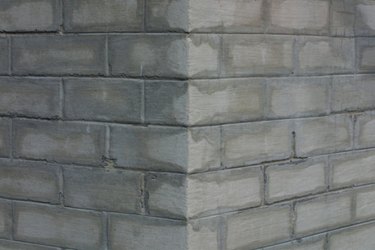
Mixing cement with sand and water will result in a paste more commonly known as cement mortar. The primary function of cement mortar is to combine varying sizes of stones for a smoother surface finish. Use cement mortar in confined places or areas where placing cement is not advisable. For all its wide uses and benefits, as well as advanced masonry applications, cement mortar owes its strength and durability to its balanced and well mixed properties.
What Is Cement Mortar?
Video of the Day
Cement mortar is an intact combination of cement and sand mixed with ample amounts of water to create synthetic paste. Its adhesive characteristics vary, depending on the amount of water added the mixture. It has four basic types. "Lean" mortar has a minimal amount of cement content while the "rich" type contains a high volume of cement. "Neat" cement, on the other hand, is pure cement, meaning it has no sand content. The "aggregate" type has coarser materials, usually gravel or fragmented rock. Use cement mortar for commercial as well as home masonry applications.
Video of the Day
Unique Features of Cement Mortar
Cement mortar consists of lime, which has the ability to support various masonry applications. It exhibits high water retention for optimal and fast curing times. It has greater water penetration qualities required for stronger masonry wall construction. Cement mortar exhibits compressive strength to meet the standards of a wide array of masonry and construction applications. Cement mortar also possesses uniform performance standards to meet the prescribed requirements in any construction in the market today.
Properties of Cement Mortar
The cement found in mortar provides strength and fills in air pockets present in sand. Sand, on the other hand, eliminates or reduces cracks produced by the contraction of cement while it sets. In most cases, adding one part cement to two parts sand will yield a proportional cement mortar volume. Cement mortar also contains Pozzolit admixture, an active mineral which is a combination of silica fume (SF) and low calcium content fly ash (FA). These elements contribute to the flexural strength and elasticity of cement mortar.
How to Mix Cement Mortar
Mix sand and cement in a conveniently sized platform or shallow container box. Spread the right amount of sand underneath the cement. Mix it with a shovel or hoe until the paste clearly shows a balanced color. Once done, make a crater of the dry mixture of cement and pour the entire amount of water. Mix from the outside toward the center until the sand and cement absorb the water. Turn the mixture rapidly, adding water if necessary for the desired texture. During masonry application, it is better to wet the bricks first, before applying the paste evenly, if using a stiff mortar.
- Book Dome: Preparation And Properties Of Mortar And Concrete
- Geo Science World: "Physical and mechanical characteristics of cement mortars and concretes with addition of clinoptilolite from Beli Plast deposit (Bulgaria), silica fume and fly ash"; V. Lilkolv, et al; 2011
- ASTM International: ASTM C1329 -- 05 Standard Specification for Mortar Cement
- TransTutors: Properties of Cement Mortar
- Chest Of Books: Cement Mortar
- FineHomeBuilding: Mortar -- What Type Do You Need?
- AskTheBuilder: "Mortar Mix for Flagstone and Paving Brick"; Tim Carter; 2011
- Estimator'sReference: Mortar Mixes
- PortlandCementAssociation: Mortar Types
- MasonryMagazine: Mixing Mortar for Properties -- The Prescription Mortar Method